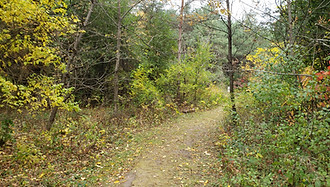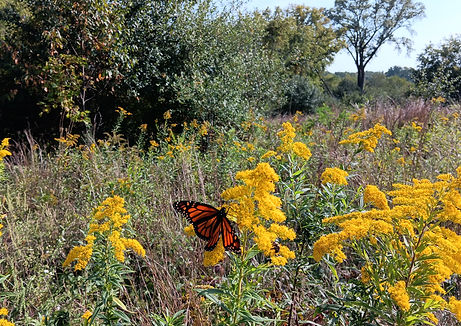"Stories of the Land" Interpretive Trailway
Stories of the Land is a signage-guided educational walk through a portion of our property with the goal of engaging hikers with the fascinating history that happened on the soil beneath their feet.
From examining the culture and history of the Indigenous Ho-Chunk people, to discovering prominent historical figures who journeyed here, to exploring applied prairie science and more, Stories of the Land enhances our educational offerings out in nature's classroom.
The interpretive trail begins just off of the parking lot. The interpretive signage is located along the Outer Loop trail.
Our trails are free and open to the public. Tour groups may contact us to schedule a guided history hike led by our staff (regular admission fees apply for guided hikes).
Funded in part by the Kohler Foundation
Marquette Trail
In addition to our Stories of the Land interpretive trailway which has a mowed-grass surface, we also offer a primitive walking path of a higher difficulty level which begins off the gravel turnaround at the end of the road. Enjoy the beauty of the Fox River. Please be sure to turn around at the "End of Trail" sign and head back the same way you came; the property beyond that sign belongs to someone else. Please stay on the footpath. We recommend not using this trail during gun deer hunting season.
Outdoor Exhibits
The Historic Indian Agency House and the Ho-Chunk Nation Museum & Cultural Center have come together to educate in powerful ways through two outdoor exhibits on our grounds.
Recreational Opportunities
Our hiking trails wind through diverse habitats, including prairies, woodlands, and wetlands. In the winter, consider taking in the scenery via snowshoes or cross-country skis. Because of our conservation efforts, the trails provide a great platform for nature studies, photography, birding, and more. School groups and scouts enjoy activities in this setting, as well. Our trails are free and open to the public. We ask that you respect the land—including carrying out any trash—so that it may be preserved and enjoyed by all for generations to come. Pets on leashes are welcome; please clean up after your pets.
Gardens and Picnicking
While you're visiting, enjoy a picnic and appreciate our gardens. Our kitchen garden showcases some of the crops that were common in the early 1800s, while our flower gardens provide a serene place to relax and ponder the lessons of history gleaned from our museum tour. The rotary garden (established by the local Rotary Club and other donors) has now become the site of the "A Landscape of Families" exhibit which features cultural horticulture that was historically important to the Ho-Chunk people. We also have a small community-sponsored heritage apple orchard.
Committed to Conservation
Our 233-acre site is one of scenic beauty and abundant wildlife. The Historic Indian Agency House is committed to the preservation of the land. As such, we have partnered with Groundswell Conservancy to establish a 100-year conservation easement on a large portion of our property.
Historic Prairie Restoration
In 1941, when the Agency house had been a museum for only a decade, the museum's garden committee sought to persuade the Wisconsin Conservation Commission to establish the museum estate as a wildlife refuge. To build their case, the planners contacted conservation legend Aldo Leopold to review the site. Leopold found that the site was not well-suited for a mammal or bird sanctuary. However, he discovered a myriad of native prairie plant species — rare survivors from the day of the Kinzies (early 1830s) when Portage was positioned on the northern edge of a prairie ecosystem covering much of southern Wisconsin. While hopes of a wildlife refuge were stymied, Leopold's optimistic report on the site's prairie potential set the stage for ongoing efforts to steward this valuable remnant of the early days through a series of conservation efforts. The prairie was an important part of the story of this historic site. It is worth the effort to preserve it.
Funded in part by:
Alliant Energy Giving for Good
C.D. Besadny Conservation Fund (NRF of WI)
Community Foundation of South Central Wisconsin
Enbridge Fueling Futures
Michael & Sally Connelly in honor of NSCDA-WI President Barbara J. Meyer
Golden Sands Resource Conservation & Development Council
The Myrtle Fund at Vanguard in honor of Daniel C. O'Connor
Cissy VD Bryson Fund of the Greater Milwaukee Foundation
U.S. Fish & Wildlife Service "Partners" Program
Rustic Road, Historic Canal, & Ice Age Trail
Agency House Road—also known as Rustic Road 69—is part of the Wisconsin DOT's Rustic Roads program, which has granted the designation to more than 100 roads that provide "leisurely travel through the state's scenic countryside." Along Rustic Road 69, just up from its intersection with E. Albert St., a foot bridge crosses over the historic Portage Canal, which is on the National Register of Historic Places. On the other side of the foot bridge is the Ice Age Trail, which is part a 1,000-mile-long National Scenic Trail carved by glaciers in Wisconsin.




_edited_edited.jpg)





_JPG.jpg)



